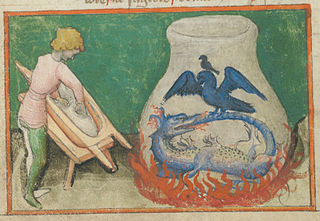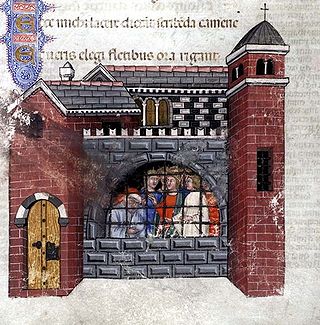Related Research Articles

Alchemy is an ancient branch of natural philosophy, a philosophical and protoscientific tradition that was historically practiced in China, India, the Muslim world, and Europe. In its Western form, alchemy is first attested in a number of pseudepigraphical texts written in Greco-Roman Egypt during the first few centuries AD.
Maximus Planudes was a Byzantine Greek monk, scholar, anthologist, translator, mathematician, grammarian and theologian at Constantinople. Through his translations from Latin into Greek and from Greek into Latin, he brought the Greek East and the Latin West into closer contact with one another. He is now best known as a compiler of the Greek Anthology.
Macrobius Ambrosius Theodosius, usually referred to as Macrobius, was a Roman provincial who lived during the early fifth century, during late antiquity, the period of time corresponding to the Later Roman Empire, and when Latin was as widespread as Greek among the elite. He is primarily known for his writings, which include the widely copied and read Commentarii in Somnium Scipionis about Somnium Scipionis, which was one of the most important sources for Neoplatonism in the Latin West during the Middle Ages; the Saturnalia, a compendium of ancient Roman religious and antiquarian lore; and De differentiis et societatibus graeci latinique verbi, which is now lost. He is the basis for the protagonist Manlius in Iain Pears' book The Dream of Scipio.

The Dream of Scipio, written by Cicero, is the sixth book of De re publica, and describes a dream vision of the Roman general Scipio Aemilianus, set two years before he oversaw the destruction of Carthage in 146 BC.

The Secretum Secretorum or Secreta Secretorum, also known as the Sirr al-Asrar, is a treatise which purports to be a letter from Aristotle to his student Alexander the Great on an encyclopedic range of topics, including statecraft, ethics, physiognomy, astrology, alchemy, magic, and medicine. The earliest extant editions claim to be based on a 9th-century Arabic translation of a Syriac translation of the lost Greek original. It is a pseudo-Aristotelian work. Modern scholarship finds it likely to have been written in the 10th century in Arabic. Translated into Latin in the mid-12th century, it was influential among European intellectuals during the High Middle Ages.
Achmet, son of Seirim, the author of a work on the interpretation of dreams, the Oneirocriticon of Achmet, is probably not the same person as Abu Bekr Mohammed Ben Sirin, whose work on the same subject is still extant in Arabic in the Royal Library at Paris, and who was born AH 33 and died AH 110.

De re publica is a dialogue on Roman politics by Cicero, written in six books between 54 and 51 BC. The work does not survive in a complete state, and large parts are missing. The surviving sections derive from excerpts preserved in later works and from an incomplete palimpsest uncovered in 1819. Cicero uses the work to explain Roman constitutional theory. Written in imitation of Plato's Republic, it takes the form of a Socratic dialogue in which Scipio Aemilianus takes the role of a wise old man.
Muhammad Ibn Sirin was a Muslim tabi' who lived in the 8th century CE. He was a contemporary of Anas ibn Malik. He is claimed by some to have been an interpreter of dreams, though others regard the books to have been falsely attributed to him. Once regarded as the same person as Achmet son of Seirim, this is no longer believed to be true, as shown by Maria Mavroudi.

A dream vision or visio is a literary device in which a dream or vision is recounted as having revealed knowledge or a truth that is not available to the dreamer or visionary in a normal waking state. While dreams occur frequently throughout the history of literature, visionary literature as a genre began to flourish suddenly, and is especially characteristic in early medieval Europe. In both its ancient and medieval form, the dream vision is often felt to be of divine origin. The genre reemerged in the era of Romanticism, when dreams were regarded as creative gateways to imaginative possibilities beyond rational calculation.
Maria V. Mavroudi is a Greek-born American Byzantinist, historian, and philologist. She is a history professor at University of California, Berkeley.

Latin translations of the 12th century were spurred by a major search by European scholars for new learning unavailable in western Europe at the time; their search led them to areas of southern Europe, particularly in central Spain and Sicily, which recently had come under Christian rule following their reconquest in the late 11th century. These areas had been under Muslim rule for a considerable time, and still had substantial Arabic-speaking populations to support their search. The combination of this accumulated knowledge and the substantial numbers of Arabic-speaking scholars there made these areas intellectually attractive, as well as culturally and politically accessible to Latin scholars. A typical story is that of Gerard of Cremona, who is said to have made his way to Toledo, well after its reconquest by Christians in 1085, because he
arrived at a knowledge of each part of [philosophy] according to the study of the Latins, nevertheless, because of his love for the Almagest, which he did not find at all amongst the Latins, he made his way to Toledo, where seeing an abundance of books in Arabic on every subject, and pitying the poverty he had experienced among the Latins concerning these subjects, out of his desire to translate he thoroughly learnt the Arabic language....

Shabbethai Donnolo was a Graeco-Italian Jewish physician, and writer on medicine and astrology.
Stephen of Pisa was an Italian translator from Arabic active in Antioch and Southern Italy in the first part of the twelfth century.

The Cyranides is a compilation of magico-medical works in Greek first put together in the 4th century. Latin and Arabic translations also exists. It has been described as a "farrago" and a texte vivant, owing to the complexities of its transmission: it has been abridged, rearranged, and supplemented. The resulting compilation covers the magical properties and practical uses of gemstones, plants, and animals, and is a virtual encyclopedia of amulets; it also contains material pertinent to the history of western alchemy, and to New Testament studies, particularly in illuminating meanings of words and magico-religious practices. As a medical text, the Cyranides was held in relatively low esteem even in antiquity and the Middle Ages because of its use of vernacular language and reliance on lore rather than Hippocratic or Galenic medical theory.
Demetrios Chloros was a 14th-century Byzantine physician, astrologer, priest and sorcerer who was tried for possessing magic books.

European science in the Middle Ages comprised the study of nature, mathematics and natural philosophy in medieval Europe. Following the fall of the Western Roman Empire and the decline in knowledge of Greek, Christian Western Europe was cut off from an important source of ancient learning. Although a range of Christian clerics and scholars from Isidore and Bede to Jean Buridan and Nicole Oresme maintained the spirit of rational inquiry, Western Europe would see a period of scientific decline during the Early Middle Ages. However, by the time of the High Middle Ages, the region had rallied and was on its way to once more taking the lead in scientific discovery. Scholarship and scientific discoveries of the Late Middle Ages laid the groundwork for the Scientific Revolution of the Early Modern Period.

Levinus Lemnius was a Dutch physician and author.
Paul Magdalino is a British Byzantinist who is Bishop Wardlaw Professor (Emeritus) of Byzantine History at the University of St Andrews. He received the 1993 Runciman Award for his monograph on the reign of Manuel I Komnenos (1143–1180), which challenged Niketas Choniates' negative appraisal of the ruler.
Enrico Dandolo was Patriarch of Grado, Italy, from 1134 to 1182. A member of a noble Venetian Dandolo family, after his appointment he put the interests of the church ahead of all other concerns.
Leo Tuscus was an Italian writer and translator who served as a Latin–Greek interpreter in the imperial chancery of the Byzantine Empire under Emperor Manuel Komnenos.
References
- ↑ Maria Mavroudi, "Occult Science and Society in Byzantium: Considerations for Future Research," in The Occult Sciences in Byzantium, pp. 84–85 online; full text downloadable.
- ↑ Mavroudi, "Occult Science and Society in Byzantium," pp. 84–85, especially note 140.
- ↑ Marie-Thérèse d'Alverny, "Translations and Translators," in Renaissance and Renewal in the Twelfth Century (University of Toronto Press, 1991), p. 438 online.
- ↑ Definitions of the five types of dreams according to the Commentarium in somnium Scipionis of Macrobius are based on Dean Swinford, Through the Daemon's Gate: Kepler's Somnium, Medieval Dream Narratives, and the Polysemy of Allegorical Motifs (Routledge, 2006), passim.
- ↑ Kathryn L. Lynch, The High Medieval Dream Vision: Poetry, Philosophy, and Literary Form (Stanford University Press, 1988), pp. 74–75 online.
- ↑ Defining the incubus as "a small being in the likeness of a satyr ... that ... presses sleepers at night in such a way that it almost kills them by suffocation."
- ↑ Steven Kruger, "Medical and Moral Authority in the Late Medieval Dream," in Reading Dreams: The Interpretation of Dreams from Chaucer to Shakespeare, edited by Peter Brown (Oxford University Press, 1999, reprinted 2002), pp. 55, 57, and 59 online.
- ↑ Librum Grecum ... fideliter per omnia emulatus sum ... non verba, que de sterilitate barbarica sunt, sed sensum utilitatis recolligendo, as quoted by Charles Burnett, "Late Antique and Medieval Latin Translations of Greek Texts on Astrology and Magic", in The Occult Sciences in Byzantium, p. 330.
- ↑ Mavroudi pp. 84–85, note 140 online with additional citations.